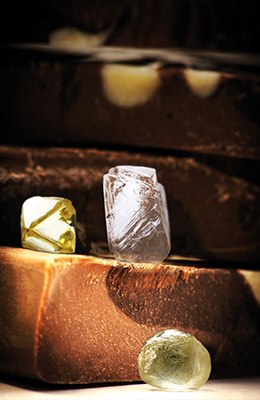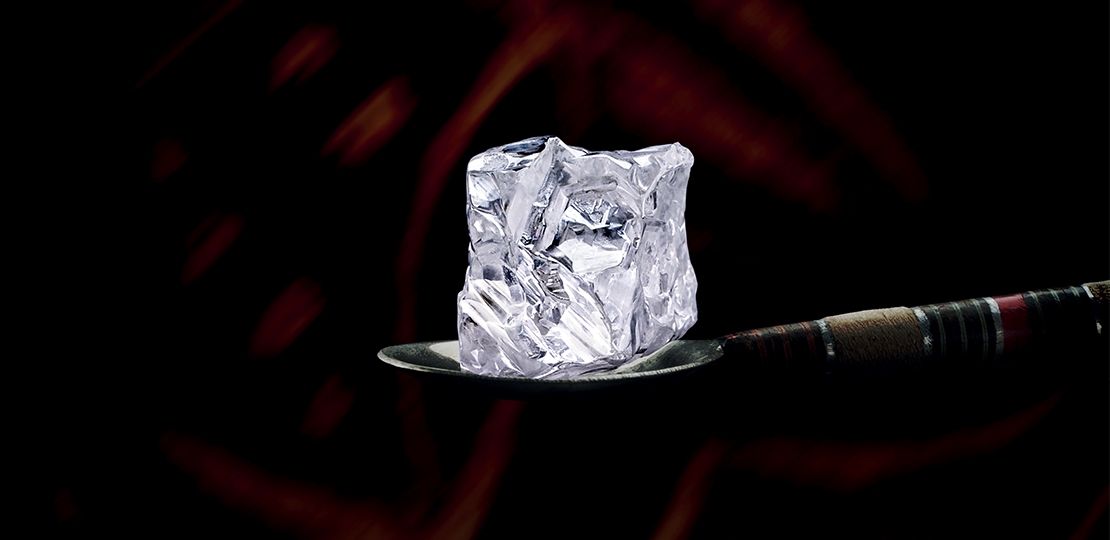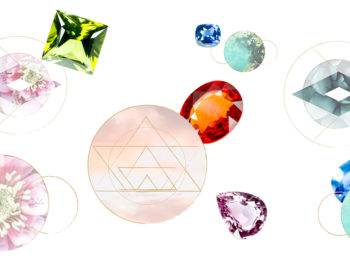Synthetic diamonds, previously reserved for industry, now stand supreme as real challengers to natural diamonds. The question however is: how much so? Can synthetic diamonds be put on a par with natural diamonds? Do they embody the future of the natural diamond which we estimate will have disappeared by 2030?
Through this new column entitled Talk, The Eye of Jewelry takes on topics which are burning news and which, through the questions they raise, herald what tomorrow’s jewelry craft may bring.
For this first edition, we chose to focus on the debate which has been stirring up the jewelry world over the last few years, between synthetic diamond proponents and natural diamond defenders.
So, we gave the floor to two experts: Jean Marc Lieberherr, CEO of the Diamond Producers Association (DPA), and Stéphane Wulwik, founder of the jewelry brand Innocent Stone, who answered our questions.
This week, we’re publishing the first part of our report, the interview with Jean Marc Lieberherr.
Do you wish to comment? Or ask me a question? Feel free to write to me at mcs@theeyeofjewelry.com

TEIOFJ: Could you tell us the difference between a natural diamond and a synthetic one?
JML: To the naked eye, artificial and natural stones look alike as they have the same physical and chemical properties. However, they can be easily distinguished using specialized equipment, as they have different growth marks and different types of inclusions. A real diamond is the fruit of growth which can last several hundred million years, whereas the lab-grown diamond is produced in just a few weeks. This difference in process leaves distinctive marks in the stone which bears witness to its origin. The inclusions found in a natural diamond are bubbles or cavities which contain materials dating back several billion years, whereas the inclusions found in a synthetic diamond are produced by a poorly-controlled industrial process and are of a totally different type as synthetic diamonds are actually industrial replicas of real diamonds.
Imagine a perfect reproduction of a Picasso, using the same pigments and the same canvas as the original work. Only an expert can tell the difference, yet that doesn’t mean to say they are totally identical. One is authentic and has particular intrinsic and emotional value given its origin, whereas the other is a replica which has but decorative value and appeals because of its relationship to the original, but has no real self-value. This analogy is perfectly applicable to natural diamonds and synthetic diamonds.
TEIOFJ: Unlike diamonds which are all graded on the 4Cs, some diamonds are IGI-certified, others bear no specific mention, especially Lightbox ones, the De Beers lab-grown range of diamonds. What’s your feeling on this? Do you think that grading synthetic diamonds could be misleading to consumers?
JML: Grading for natural diamonds is essential given the fact that the more perfect and uncolored the stones, the more exquisite and also the more uncommon they are and, as such, the more expensive. This is used to appreciate the natural differences between stones which will then dictate the price which they will be traded at. Of course, synthetic diamond producers would like to adopt all the codes which apply to natural diamonds in order to imply equivalence between products and it’s of vested commercial interest for some laboratories to provide this service. However, if we dig a bit deeper into the question, the absurdity of such a move is flagrant. As synthetic diamonds are an industrial product, there’s no need whatsoever to appreciate natural differences. This type of grading goes hand-in-hand with quality assurance, not with gemology, and inclusions with manufacturing defects.
Moreover, the stones are increasingly standardized and there is therefore no impression of rarity. Tomorrow, a synthetic stone without defects will be the generalized standard and their value will be totally dictated by their production cost. We already know that the per-carat production cost for an industrial stone decreases with stone size. It’s the exact opposite for a precious stone, given the rarity of large-sized stones. This is probably the reasoning adhered to by the Lightbox brand and its CEO, Bruce Cleaver, whenever he states “We don’t think they deserve to be graded. They’re all the same.” (talking about synthetic diamonds, cf. interview with Bruce Cleaver, De Beers CEO, accessible here).
TEIOFJ: The issue of synthetic diamond value and price is a subject of debate. If we base ourselves on data from the “Global Diamond Industry 2018” study carried out by Bain & Company, do you agree that the real value of a synthetic diamond stands at around 15% of that of a real diamond. In your opinion, does this lower-price position actually make for a serious rival or, on the contrary, is this price not more-so more to the natural diamond’s advantage, given it is therefore perceived as more luxurious?
JML: Ok, let’s go back to the analogy of the master artwork. A natural diamond is a precious stone several billion years old, and its production is constantly decreasing. The natural diamond has real intrinsic value, whereas a synthetic diamond is an artificial stone whose production regularly increases and whose prices constantly decrease. Our OpinionWay survey for France shows consumers’ attachment, in particular that of Millennials*, to the symbolism of the diamond. This symbolism is directly linked to its history, to its natural origin and to its rarity. A diamond cannot be reduced to a cluster of atoms, something which synthetic diamond producers who try to apply all the codes of natural diamonds to sell their product, including price, have perfectly understood. This strategy has its limits however, moreover consumers are beginning to understand that they’re dealing with highly-different products and this can now be seen through prices.
Take for example, Lightbox diamonds which are currently sold for €600 retail price, and the synthetic versions of colored stones (ruby, etc.) are now sold at 10% of the natural stone price. The synthetic stones will definitely find their market, the costume jewelry segment, but cannot be promoted as alternatives to natural stones.
 TEIOFJ: You also tackle the idea that only a lab-grown diamond is eco-friendly and responsible. In this respect, you explain that “bringing the carbon footprint of a synthetic diamond produced in China or in India, via the “CVD” process, into the perspective of a produced carat, is much greater than that of a natural diamond given its high energy consumption”. Do you think that it would be appropriate to introduce diamond rating (for both natural and synthetic) to know their real ecological footprint and to better inform the consumer?
TEIOFJ: You also tackle the idea that only a lab-grown diamond is eco-friendly and responsible. In this respect, you explain that “bringing the carbon footprint of a synthetic diamond produced in China or in India, via the “CVD” process, into the perspective of a produced carat, is much greater than that of a natural diamond given its high energy consumption”. Do you think that it would be appropriate to introduce diamond rating (for both natural and synthetic) to know their real ecological footprint and to better inform the consumer?
JML: I believe that it is more than appropriate to inform the consumer about the reality of the impact of what they buy, irrespective of the sector. We will soon publish a report produced by a renowned independent company (Trucost, part of the S&P Group) which gives a very clear and quantified indication of the environmental impact of natural diamonds produced by all the members of the DPA. This level of transparency is unprecedented. The environmental impact of natural diamond mining is today very low and consists mainly of carbon emissions. All the mining companies are working towards reducing these. It is our responsibility to provide transparent information about the ecological footprint of natural diamonds, but the real question which consumers are more interested in is that of the human and social impact of diamonds. And in this respect, we will soon be able to provide verified information which demonstrates the positive impact of natural diamond mining on local populations.
TEIOFJ: With hindsight, was the natural diamond industry not wrong when it showed its reluctance to address consumers’ need for information?
JML: Yes, without a doubt, there was somewhat of reluctance to communicate on the topic. Over the last few years however the trend has been reversed and transparency is now central to our action. Up until now, we never published sustainability reports produced by mining companies, basically because we didn’t have the tools to do so. However, now it’s done, we’ve collected objective data about the sector and we’re going to publish it in the coming months.
TEIOFJ: The Bain & Company study identifies three key trends for the diamond market. One of these focuses on the presence of lab-grown diamonds and their effect on the demand for natural diamonds. It explains that in the coming years, the real challenge for the natural diamond industry will be to manage to distinguish “its stones from lab-grown diamonds” so that the effect on demand by 2030 will be limited to 5% or 10% in terms of value. How do you intend to take up this challenge? What actions are you planning to initiate to continue to create consumer preference, in particular that of Millennials?
JML: It’s a long drawn out subject and the role of the DPA. We’ve just started investing in the US, in India and in China via our communication platform “Real is rare, real is a Diamond”, which highlights the unique symbolic value (and monetary) of a rare, natural product, which is several billion years old and eminently authentic in an ever-more virtual and artificial world. Our global investment today stands at some 60 million euros. Moreover, we are communicating and we’re going to boost our effort on the industry’s positive impact. After 10 years of silence, we’re getting organized to take the floor once again because we’re convinced that the promise of a natural diamond, which is several billion years old, which symbolizes love, authenticity and sincerity, has never been as relevant as it is today. In France, we’re working with our colleagues from “Collectif Diamant” to take to the stage again, in particular through the media.
TEIOFJ: How do you see the market share between natural diamonds and synthetic ones in the coming years?
JML: The synthetic diamond market will continue to grow and will establish itself as a separate segment, i.e. a low-cost, costume jewelry segment. In the future, the price difference between the natural diamond and the synthetic diamond will continue to widen. It will be fixed at around 85% to 90%, similar to that of colored stones.
There is high demand for natural diamonds and this will continue to increase, in particular in India and China, whereas production will stagnate or decrease in the coming years. This will bolster natural diamond prices.
As regards the synthetic diamond, prices will inevitably continue to decrease, as sure as the Earth is round, because it’s all to do with a very simple economic rule: the price of an undifferentiated industrial product manufactured at increasingly lower costs and in increasingly higher amounts can only decrease. Some will manage to promote the product via a strong brand, like Swarovski for example, and will create attractive collections. Others will strive to position it as a luxury product, like a real diamond, and we’re convinced that they’ll fail in the midterm because consumers are not fooled and they won’t be able to distinguish their product from identical, low-cost products arriving from Asia. Others will take on a low-cost volume approach, like Walmart in the US, and will count on large volumes in the low-cost, costume jewelry segment. It’s still the very early stages, but that’s what we forecast.
*According to the OpinionWay survey carried out for the DPA, 73% of Millennials believe that the diamond is the precious stone par excellence.




